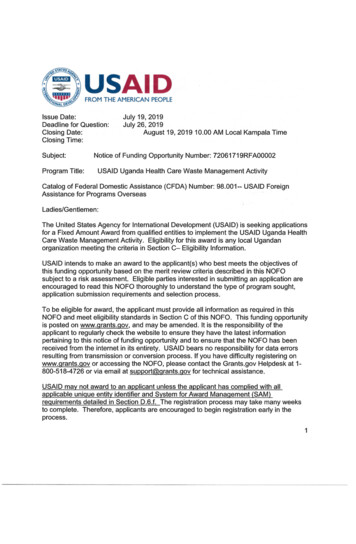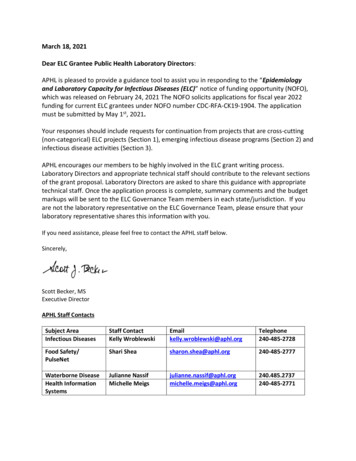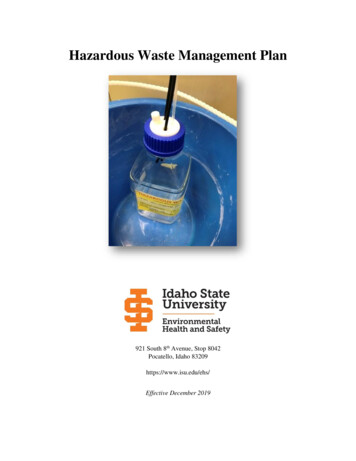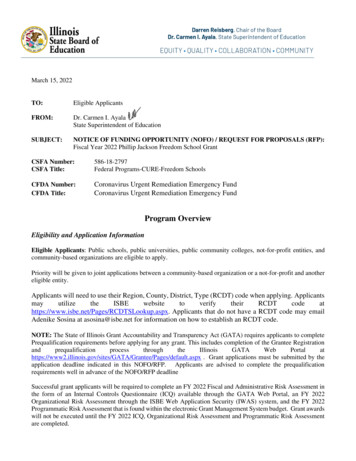
Transcription
TABLE OF CONTENTSSection A – Program DescriptionSection B – Federal Award InformationSection C – Eligibility InformationSection D – Application and Submission InformationSection E – Application Review InformationSection F – Federal Award Administration InformationSection G – Federal Awarding Agency ContactsSection H – Other Information3
SECTION A: PROGRAM DESCRIPTIONA.1 AUTHORITYThis funding opportunity is authorized under the Foreign Assistance Act (FAA) of 1961, asamended. The resulting award will be subject to 2 CFR 200 – Uniform AdministrativeRequirements, Cost Principles, and Audit Requirements for Federal Awards, and USAID’ssupplement, 2 CFR 700, as well as the additional requirements found in Section F.A.2 TERMINOLOGYNote: The term “program” as used in 2 CFR 200 and this NOFO is typically considered byUSAID to be an Activity supporting one or more Project(s) pursuant to specific DevelopmentObjectives. Please see 2 CFR 700 for the USAID specific definitions of the terms “Activity” and“Project” as used in the USAID context for purposes of planning, design, and implementation ofUSAID development assistance.A.3 PROGRAM DESCRIPTIONThrough this NOFO, USAID/Uganda is inviting Applicants to apply for the Health Care WasteManagement Activity (HCWMA). The principal purpose of the HCWMA is to remediate thepotential human health and environmental impacts of Voluntary Medical Male Circumcision(VMMC), Maternal, Newborn and Child Care (MNCH) and Family Planning (FP)-relatedhazardous health care waste (HCW) through safe and proper segregation, collection, storage,transportation, treatment, and disposal. The HCWM Activity will be implemented at 378 healthfacilities that provide PEPFAR-funded VMMC services in 95 districts throughout Uganda. TheRecipient will collect, weigh, package, label, transport, treat and dispose of at least the minimumquantity of hazardous HCW that the Recipient will propose in their application specified for eachmonth, which shall exceed 400,000kgs over one year. The HCWM Activity will also implementan innovation program in 12 selected high volume health facilities to improve HCWM practicesat facility level in accordance with Ministry of Health (MoH), National EnvironmentalManagement Authority (NEMA) and World Health Organization (WHO) regulations andguidance. The innovation program will support the 12 selected health facilities listed underSection 4(4) of this Program Description for year 1, to become models of excellence for HCWMpractices, which shall be emulated by the rest of the health facilities during the life of the project.In the 12 model health facilities, the Recipient will will propose specific activities in furtheranceof this objective. The HCWM activities in the innovation health facilities will include properHCW segregation (non-hazardous HCW from hazardous HCW, and segregation of hazardousHCW by category), use and maintenance of personal protection equipment (PPE) and training ofstaff in safe HCW handling. It will also prepare health facilities to purchase private sectortransport, treatment, and disposal services for their total HCW burdens once the HCWM Activityis completed.4
A.3.1 BackgroundSince March 2017, USAID supported HCW collection and disposal activities in conjunction withPEPFAR-funded VMMC procedures through a USAID Washington, DC field mechanism,Strengthening High Impact Interventions for an AIDS-Free Generation (AIDSFree), a cooperativeagreement led by JSI Research & Training Institute (JSI).PEPFAR supports VMMC throughout Uganda as an HIV/AIDS biomedical prevention measure.PEPFAR-supported VMMC services are provided through USAID, the U.S. Centers for DiseaseControl (CDC), and the U.S. Department of Defense (DOD). VMMC interventions generatehazardous HCW, which, in accordance with USAID’s environmental documentation, “to thegreatest extent practicable, USAID Implementing Partners and/or the medical facilities andoperations involved, as appropriate, must have adequate procedures and capacities in place toproperly manage and dispose of such commodities.” The “adequate procedures” referred to in theUSAID environmental documentation are U.S. Government, internationally accepted, and/orGovernment of Uganda standards.With support from PEPFAR, the MoH produced National Guidelines for Managing Health CareWaste Generated from Safe Male Circumcision Procedures (August 2013). These guidelinesprovide detailed procedures for waste segregation, storage, transport, treatment, and final disposalof each type of waste generated from VMMC procedures. This HCWM Activity will beimplemented in accordance with MoH, NEMA and WHO regulations and guidance.In conjunction with PEPFAR-funded VMMC procedures, USAID’s Environmental Proceduresspecifically require the collection, treatment, and safe disposal of VMMC waste. Health facilitiesalso generate waste through activities other than VMMC procedures and typically, healthfacilities do not segregate VMMC waste from non-VMMC waste but follow the standard (andGoU requirement) to segregate HCW by waste category and sub-category, as described above.Broadly, HCW generated by health facilities falls into the following categories and subcategories: Non-hazardous (75%-90%): waste that has not been infected or contaminated by blood orbody fluids. It is similar to normal household or municipal waste and should be managedby municipal waste services (e.g., uncontaminated packaging materials and plasticcontainers, food scraps, soft drink cans, and paper). Hazardous 10%-25%): includes sharps, infectious waste, pathological waste, anatomicalwaste, pharmaceutical waste, and radioactive waste. To protect the people who handle it,the public, and the environment, hazardous waste must be safely collected, packaged,stored, transferred, treated, and disposed.Hazardous waste generated at health facilities entail health risks and these include: Sharps waste: materials that can puncture skin, such as needles, blades, and broken glass. Infectious waste: contains agents that are infectious to humans and animals.5
Pathological waste: includes body organs that are removed from the body because they arediseased, and tissue as well as blood and other body fluids that are removed from the bodyfor lab tests to determine the underlying cause of disease. Anatomical waste: comprises recognizable body parts such as limbs (e.g., legs, fingers)that have been cut off for a medical reason. Pharmaceutical waste: includes all active agents and chemicals meant for prevention,treatment, and diagnosis of diseases among humans and other animals. Examples includeexpired medicines, condoms, lab reagents, and banned medicines. Radioactive waste: includes all liquids, gases, and solids contaminated with ionizingradiation, which can affect human genes. Effluents: fluids generated from medical services, such as washing equipment used onpatients, or waste water from washing linens used during labor. Heavy metals: mercury, silver, and other metals used in the health sector; these metals canbe toxic, corrosive, flammable, reactive, explosive, shock sensitive, or even damaging tohuman genes. Metal scrap: includes all metals that are deemed to be of no further use to the healthfacility, such as surgical forceps, scissors, needle holders, and scalpels.The hazardous HCW of particular concern for this activity is from VMMC procedures, MNCHand FP activities and the main focus of this activity are sharps, infectious waste, highly infectiouswaste, pharmaceuticals, metals, plastics, anatomical and glass (AIDSFree Progress Reports).Based on the PEPFAR target for 2019-2020 of 800,000 VMMC procedures/year and theassumption that each VMMC procedure produces 0.5 kg of hazardous HCW 1, the amount ofwaste generated by PEPFAR-supported VMMC procedures is estimated at 400,000 kg/year. Thisis only a small portion ( 5%) of the total HCW generated at health facilities. Weekly averagenon-VMMC HCW generation rates2 (per facility) are:o Hospital – 1500 kgo HC VI – 550 kgo HC III – 90 kgo Weighted average per HC III and above – 278 kg/weekPoor segregation (non-hazardous from hazardous HCW) increases the amount of HCW that has tobe treated as hazardous, thus increasing the cost of HCW handling. At the point of generation,HCW (both VMMC and HCW generated by other medical procedures) should be segregated bythe categories of HCW mentioned above. However, due to poor segregation practices about 80%of the waste generated is considered and treated as hazardous due to co-mingling of nonhazardous waste with hazardous waste that results in the entire stream being treated as hazardous.With improved segregation the amount of hazardous HCW could be decreased to 10 to 25% ofthe total HCW generated at health facilities. USAID, 2019).Despite the significant progress made in HCWM in Uganda, health facilities continue to facechallenges to ensure HCWM is a key component of infection prevention and control in health1Uganda Ministry of Health, National Guidelines: Managing HealthCare Waste Generated from Safe MaleCircumcision Procedures, 2013. Waste volume/procedure will decrease as the number of reusable kits increase andnon‐recyclable kits decrease.2GLSL, “GLSL PRESENTATION TO DALBERG ADVISORS shared with Dalberg 18 2 2019”, p.86
facilities. This can be attributed to: limited health facility budgets, in which HCWM is often a lowpriority relative to other activities that more directly contribute to health service delivery; limitedincentive of health facility leadership to seek improved methods for HCWM, as the ‘polluterpays’ principle does not apply; and the prevalence of open burning and other environmentallydamaging techniques as facilities are not pushed to consider externalities, e.g., health impacts onsurrounding communities (USAID, 2019), and therefore, they appear less costly than theyactually are.HCWM Institutional FrameworkThree GoU entities oversee HCWM and therefore, are integral to the implementation of theHCWM Activity: NEMA licenses and monitors all HCWM companies in the market. Specifically, NEMA’srole in HCWM is to collaborate with lead agencies to enforce standards; conductindependent audits of transportation, final disposal sites, and employee training and use ofpersonal protection equipment (PPE); and issue licenses to and monitor transporters andtreatment and disposal facilities. The MoH is the lead agency working with NEMA on HCW, playing an enforcement role,as well as setting HCW strategy and policies. Local Councils provide trading licenses to HCW companies and set and enforce therequirement that all health facilities have waste management contracts.In addition, the National Drug Authority (NDA) and the Uganda National Bureau of Standards(UNBOS) register HCWM service providers.A.3.2 Program Goals And ObjectivesThe overall goal of the proposed HCWM Activity is to remediate the potential impacts on humanhealth and the environment of HCW generated in conjunction with PEPFAR-funded VMMCprocedures and MNCH and FP activities. To accomplish this goal, this HCWM Activity willpromote improved HCWM practices at the facility level and will support VMMC, MNCH and FPrelated hazardous HCW collection, transport, storage, treatment, and disposal service provision at378 health facilities that carry out PEPFAR supported VMMC in 95 districts and up to 50additional facilities that may be accredited over the course of the three year implementationperiod to provide VMMC services.The recipient will also implement an innovation program in 12 high volume health facilities listedin this solicitation for the first project year, which will build them to become models of excellencein good HCWM practices.Ultimately, USAID envisions that by supporting the HCWM Activity, health facilities will adopta more sustainable and environmentally sound HCWM practices, plan and budget for HCWM,and will be prepared to purchase HCWM services that cover the full HCW spectrum once theHCWM Activity ends.7
A.3.3 Activities and TimelinesActivities that support the HCWM Activity goal are the following:(1) Finalize a Three-Year Implementation Plan. Based on the Draft Implementation Plansubmitted as part of the application, develop the final Three-Year Implementation Plan, inconsultation with USAID. The Three-Year Implementation Plan will be updated annually toproduce the Year 2 and Year 3 Work Plans. The Final Implementation Pan shall compose of thefollowing elements:(a) The HCW Collection Schedule will be finalized, in consultation with USAID, as part ofthe Final Three-Year Implementation Plan. The Applicant shall propose a realistic schedulethat covers hazardous HCW collection, transport, storage, treatment, and disposal from the378 PEPFAR-supported health facilities in the 95 target districts where PEPFAR supportsVMMC procedures. (See attached list of districts and facilities and the anticipated monthlynumber of VMMC procedures/facility). In addition, the Plan should include a schedule ofactivities to be conducted under the innovation program in the 12 model sites during the firstyear.(b) The Communication and Coordination Plan developed for the application will befinalized, in consultation with USAID, as part of the Final Three-Year Implementation Plan.The plan will clearly describe a procedure for coordinating with district focal persons andhealth facilities on the VMMC, MNCH and FP HCW collection schedule in advance and onschedule changes and for communicating through monthly calls to each district to confirmthat waste has been collected in accordance with the agreed routing and schedule. The planwill also include measures for communicating and coordinating with USAID when HCWMconcerns require immediate attention.(2) Develop the Environmental Mitigation & Monitoring Plan (EMMP). Based on the USAIDMission Environmental Officer’s orientation at the post-award conference, an EMMP will bedeveloped that describes environmental mitigation measures including measures related to risksfrom climate change, a schedule for site visits to monitor implementation of mitigation measures,and responsible parties for implementing, monitoring, and reporting on mitigation measures. TheRecipient is responsible for implementing and monitoring mitigation measures and for ensuringthat all conditions of the USAID Initial Environmental Examination are implemented.(3) Services for the management of VMMC, MNCH and FP-Related Hazardous HCW, includingcollection, transport, storage, treatment, and disposal. The Recipient will collect, transport, store,treat, and dispose of VMMC, MNCH and FP-related hazardous HCW based on the collectionschedule developed in the application and finalized upon award:(a) As part of the management of hazardous HCW, the Recipient will collect, package, label,and weigh VMMC, MNCH and FP-related HCW at the source for transport to a storage,treatment, and/or disposal facility. At the source, VMMC, MNCH and FP-related hazardous8
HCW will be weighed using a calibrated weighing scale, in the presence of a health facilityrepresentative, and the weights will be recorded, by category of HCW, on a standard wastetransfer note. Staff involved in HCW handling are required to use PPE and must beadequately trained in use and maintenance of PPE and minimizing risks to human health andthe environment.The minimum amount of VMMC-related hazardous HCW that the Recipient must collect(collection includes packaging, labeling, and weighing) from the 378 health facilities is400,000 kg/year (based on the 2019 PEPFAR COP target of 800,000 procedures/yearproducing 0.5 kg of VMMC-related hazardous HCW waste/procedure). Given that VMMCrelated HCW is a small portion of the total HCW burden at health facilities, the Recipientwill collect, store, treat, and dispose of significantly higher amounts of hazardous HCW,especially MNCH and FP waste therefore the recipient shall propose in their application aminimum annual hazardous HCW amount that they propose to collect, store, treat, anddispose of, as well as a collection schedule of the proposed amount broken down by monthsand the frequency of pickup for each facility. The recipient shall pick up waste from facilitiesat least three times a month. In facilities producing high volume of VMMC and MNCH andFP-related HC waste, weekly waste collection is encouraged.The Recipient will encourage good segregation and storage practices and will monitorsegregation and storage at the facilities being served. The Recipient will record noncompliance and the reasons thereof and report it to USAID on a monthly basis. The recipientmay use a “scorecard” to rate facilities in proper handling and segregation of medical waste,especially hazardous waste, or other methods.(b) Transport, store, treat, and dispose of VMMC, MNCH and FP-related hazardous HCW.Only trucks licensed for transporting hazardous waste will be used to transport HCW.Storage (of consolidated HCW awaiting treatment and disposal), treatment, and disposalshall be undertaken in accordance with MOH, NEMA and WHO Guidelines based on thecategory of waste. Staff involved in HCW treatment, transport, and disposal are required touse PPE and be adequately trained in use and maintenance of PPE and minimizing risks tohuman health and the environment. Method of treatment and final disposal locations will berecorded by volume for each category of hazardous HCW.(4) Setting up models of excellence in HCWM practices at innovation program selected facilities.The Recipient will implement an innovation program during the first year of the project aimed atmaking the following 12 high volume health facilities models of excellence in HCWM.FacilityAverage amount of hazardous waste generated byfacilityUSAID:Lalogi HCIV5,427 kg9
Tororo Hospital7,744 kgKamuli Hospital6,563 kgKihihi HC IV3,491 kgAnyeke HC IV3,776 kgSembabule HC IV3,796 kgRukunyu HC IV3,494 kgWakiso HC IV5,495 kgMubende Hospital7,470 kgCDC:Toroma HC4980 kgDepartment of Defense:Kayunga HospitalBombo General Military Hospital4,820 kgnot known military information hard to getKey issues of poor health care waste management at these facilities are: Poor infection prevention and control (IPC) in the health facilities.Poor disposing of infectious waste health care waste due to a lack of functioning technology andinadequate HCWM planningThe Recipient will work with selected facilities to improve facility-level HCWM practices to thelevel that can be exemplified in meeting MOH, NEMA and WHO environmental, health, andsafety standards.The recipient will provide a comprehensive report on the results of theinnovation program at the end of year 1 to inform USAID’s further programming. Such reportshall describe the initial issues experienced and addressed with each facility, actions taken,impactand outcome of the interventions, results achieved, obstacles encountered lessons learned,remaining shortcomings at the end of the program, recommendations for the future and anypertinent observations that helps USAID’s programming to make HCWM more effective. Theproof of concept will be designed to address the following challenges among others: Improper HCW segregation at health facilities (hazardous from non-hazardous waste andfurther, into categories of hazardous waste) Lack of adequate hazardous waste storage space at health facilities Absence of bin liners and other commodities needed for sound HCWM at health facilities Open burning or dumping of hazardous HCW co-mingled with non-hazardous waste Insufficiently trained staff at health facilities, in particular, janitorial staff Lack of awareness at management/decision-maker levels of the need for safe HCWM10
Lack of awareness at management/decision-maker levels of the need to budget forHCWM Lack of local authority oversight of HCWM practices Inadequate, inaccessible personal protection equipment (PPE) and any other issuesrecorded during implementation.The innovation program will require close collaboration with USAID to: Identify approaches to monitor during implementation at each facility type in coordinationwith District Authorities. Finalize the monitoring methodology to be used to evaluate successes and shortcomings.Illustrative approaches are: Environmental Audit (or rapid environmental review): Conduct an Environmental Audit and use this to engage with health facility management to raise awareness of theenvironmental risks of inappropriate, unsafe HCWM practices.Cost-Benefit Analysis: Engage with health facilities to highlight the economic benefits ofsound HCWM (properly segregating hazardous from non-hazardous HCW and furthersegregating into hazardous waste categories).Raise Awareness of Full Program Cost and Prepare the Health Facility to Budget and Payfor HCWM: Provide health facilities with a full costing of HCWM, illustrating thereduced cost the facility would pay with proper segregation of hazardous from nonhazardous HCW and ensure the facility is aware that HCWM will be their responsibilitywhen this USAID HCWM Activity is completed.Facilitate Provision of Commodities: Identify constraints to safe, proper HCWM relatedto lack of key commodities, e.g., PPE, bin liners, waste bins, sharps containers (safetyboxes), disinfectants, temporary secure storage space at health facilities, and identifymeasures to obtain the commodities.Waste minimization: Provide support for improved purchasing policies and stockmanagement practices.Display of written guidelines and job aids for health facility staff and train on theguidelines.Advocacy with District CouncilsThe recipient will receive a bonus payment at each pilot facility on the cost of interventions at agiven facility for successfully reducing the average hazardous HCW stream by 40-70% of thatfacility by the end of year 2 of the Activity based on the baseline of hazardous and non-hazardousHCW amounts at innovation facilities at the following rates:Rate of reduction to the amount (weight) ofhazardous HCWPercentage of Bonus over annual service costof the facility 40%5% 50%10%11
60%15% 70%20%The following milestone schedule shall govern activity implementation. USAID will pay the predetermined price for completion of each milestone after the grantee has presented thedeliverables set forth herein. [The milestones below are illustrative. Applicants may proposechanges in the interest of efficient implementation within the framework of this ProgramDescription]Table 1. Illustrative Milestones for HCWM ActivityMilestoneDescription of Main ActivitiesDeliverables/Verification Method1) Three-YearImplementation PlanFinalizedRecipient will finalize the Three-YearImplementation Plan, based on the draftdeveloped for the grant application. TheFinal Implementation Plan will contain theelements described in the Instructionssection of the RFA, and will be finalized inconsultation with USAID.Based on the USAID Mission EnvironmentalOfficer’s orientation at the post-awardconference and the pertinent instructions inthe RFA, the Recipient will develop anEMMP that describes environmentalmitigation measures, a schedule for sitevisits to monitor implementation of mitigationmeasures, and responsible parties forimplementing, monitoring, and reporting onmitigation measures.The Recipient will collect VMMC-relatedhazardous HCW (and any MNCH and FPwaste in excess of the minimum monthlyhazardous HCW amount that the recipientwill propose) based on the collectionschedule developed in the application andfinalized 30 days after award. The Recipientwill: Collect, package, label, and weighVMMC-related hazardous HCW(andany MNCH and FP waste that atleast at the minimum monthlyhazardous HCW amount that therecipient will propose) at least threetimes/month from each of the 378health facilities in 95 districts. Transport, store, treat, and disposeof VMMC, MNH and FP -relatedHCW in accordance with NEMA,Final Three-YearImplementation Plan, includingthe Communication &Coordination Plan and theCollection Schedule approvedby AOR.2)EnvironmentalMitigation &MonitoringPlanDeveloped3) VMMC,MNCH and geTreatment &DisposalEstimatedTime toCompleteDeliverables30 daysafter awardFinal EMMP approved by AORand Mission EnvironmentalOfficer60 daysafter awardMonthly report with thefollowing information: Compiled and completedstandard waste transfernotes with recorded weightsby category of HCW perdistrict and by wastecategory, certified by healthfacilities and the respectivedistrict health officers of thesatisfactory collection ofhazardous HCW to thesatisfaction of the AOR; Any changes from theapproved collectionschedule; Type of treatment/categoryof HCW; Final disposalMonthlyover thethree-yearperiodAmount(TBD)12
4)Interventionsfor improvingHCWM atInnovationFacilities5) Results inimprovingHCWM atInnovationFacilitieslocations/category of HCW;andA “scorecard” that evaluatessegregation practices ateach target health facility sothat USAID can act on noncompliance.Report on the actualmonthly cost of the wastemanagement servicesprovided to each facility.Periodic reports on completedinnovation activities at eachfacility as verified by thecognizant manager of a facility.MOH and WHO guidelines basedon the category of waste. Monitor and report on segregationpractices at health facilities.Provide report on the actual monthlycost of the waste managementservices provided to each facility. The Recipient willFinalize the innovative approaches(developed for the grant application) that willbe implemented at target facilities listedunder 4(4) of this Program Description toimprove HCWM practices; and Finalize the monitoring methodology(developed for the grant application)to be used to evaluate successesand shortcomings, including abaseline of hazardous and nonhazardous HCW amounts atinnovation facilitiesThe Recipient will conduct the innovationprogram in close coordination withinnovation health facilities and districtofficials and will: Based on the monitoringmethodology, evaluate successesand shortcomings in improvingHCWM practices at innovationfacilities (see above, ActivityDescription for expected results); Determine the reduction (amount ofkg) in hazardous HCW handled atthe facility that can be attributed tothe innovation program (from theestablished baseline of hazardousand non-hazardous HCWgenerated/innovation facility)Report on the Innovation Program in HCWMThe recipient will provide acomprehensive report on theresults of the innovationprogram to inform USAID’sfurther programming. Suchreport shall provide a summaryof innovation programimplementation and results anda detailed report to describethe initial issues experiencedUponcompletionof eachproposedmilestoneWithin 90days of theend of Year1Bonuspayment onthecost oftheinnovationprogram ateach13
facilityforsuccessfullyreducing thehazardousHCWstreamby 40to 70%of agivenfacilityin theprogram untilthe endof year2.and addressed with eachfacility, actions taken at eachfacility, impact and outcome ofthe interventions, and theresults achieved, obstaclesencountered lessons learned,remaining shortcomings at theend of the program,recommendations for the futureof what worked and what didnot, innovative approaches inwaste management or toincentivize health facilities toadopt sound HCWM practices,and any pertinent observationsthat helps USAID’sprogramming to make HCWMmore effective.6) ConductPerformance &EnvironmentalMonitoringYear 27) Year 2 WorkPlanDeveloped8) ConductPerformance &EnvironmentalMonitoringThe Recipient will implement the EMMP.Annual Report to USAID willinclude: Aggregate data of theamount of HCWcollected, stored,transported, treated,and disposed duringthe year Annual cost of wastemanagement servicesprovided to eachfacility Annual EMMPreporting Annual compliancereport (including acompilation of datafrom monthly“scorecards”) Highlights ofimplementationsuccesses andchallenges30 daysaftercompletionof Year 1Based on the Final Three-YearImplementation Plan, lessons learned fromYear 1, and expectations for Year 2hazardous HCW collection; and inconsultation with USAID, the Recipient willdevelop the Year 2 Work Plan.The Recipient will implement the M & EProgram and the EMMP.Year 2 Work Plan, includingan updated CollectionSchedule30 daysaftercompletionof Year 1Annual Report to USAID willinclude: Aggregate data of theamount of HCWcollected, stored,30 daysaftercompletionof Year 214
Year 39) Year 3 WorkPlanDeveloped10) ConductPerformance &EnvironmentalMonitoringBased on the Final Three-YearImplementation Plan, lessons learned fromYear 2, and expectations for Year 3hazardous HCW collection; and incoordination with USAID, the Recipient willdevelop the Year 3 Work Plan.The Recipient will implement the M & EProgram and the EMMP.transported, treated,and disposed duringthe yearAnnual cost of wastemanagement servicesprovided to eachfacilityAnnual EMMPreportingAnnual M & E report(including acompilation of datafrom monthly“scorecards”)Highlights ofimplementationsuccesses andchallengesYear 3 Work Plan, includingan updated CollectionSchedule30 daysaftercompletionof Year 2Annual Report to USAID willinclude: Aggregate data of theamount of HCWcollected, stored,transported, treated,and disposed duringthe year Annual EMMPreporting Annual M & E report(including acompilation of datafrom monthly“scorecards”) Highlights ofimplementationsuccesses andchallengesAt thecompletionof theHCWMActivity (endof Year 3)In accordance with the requirements of completing milestones of activity implementation set forthin the Milestone Table, the Grantee will submit the following reports:(1) Submit monthly reports to USAID pertinent to Milestone 3, HCWM Services. The Recipientwill submit monthly reports to USAID with the following information: Compiled and completed standard waste transfer notes with recorded weights by categoryof HCW per district and by waste category, certified by health facilities and t
of the waste generated is considered and treated as hazardous due to co-mingling of non-hazardous waste with hazardous waste that results in the entire stream being treated as hazardous. With improved segregation the amount of hazardous HCW could be decreased to 10 to 25% of the total HCW generated at health facilities. USAID, 2019).










